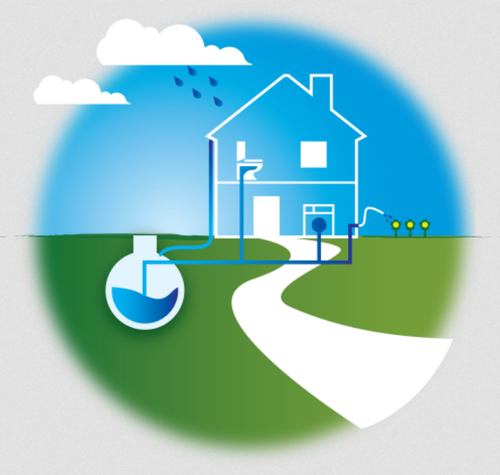Rainwater harvesting is an essential practice that can help conserve water and reduce dependency on municipal water supplies. In this article, we will cover everything you need to know about rainwater harvesting, including its benefits, methods of collection, storage, and uses.
Rainwater harvesting is collecting and storing rain for on-site reuse, rather than letting it run off. The collected water is used for different purposes, e.g. agriculture, gardening, irrigation etc.
This article explores many rainwater harvesting methods. We will also read about above ground rainwater harvesting systems.
Rain Water Harvesting is the only solution for water crisis in India.

What is Rainwater Harvesting?
It is a simple, indigenous technology which has been practiced for hundreds of years in India. The concept involves rainwater collection, either in natural reservoirs (aquifers) and/or in built tanks.
RWH also known as Rainwater Harvesting, helps to achieve water self-sufficiency, raises groundwater levels, improves groundwater quality and contributes to soil erosion reductions. It’s a costlier and easier system to maintain.
In this Article, we will Read about Rain Water Harvesting Designs, Borewell Contractors, Groundwater Dowsing Survey, Rain Water Harvesting, Rain Water Treatment, Soil Resistivity Survey, Water Conservation Systems, Water Survey, Borewell Designs, Borewell Drilling, Borewell Management Services, Borewell Methods, Borewell System Setup, Ground Water Survey, Rain Water Harvesting Systems, Bore Well Management, Water Dowsing Survey.

Rain water harvesting is a collection of rainwater which falls into storage tanks, ponds or aquifers into catchment areas such as roofs, terraces, lawns, pavements, etc. Rainwater harvesting is an age-old practice, which by rising groundwater levels offers a solution to the issue of increasing water demand. It also helps to monitor the run-off of water into drains and mitigates the problems arising from water logging.
Rainwater can be harvested from rooftops, paved and unpaved fields, lawns and water can be processed to meet a building’s diverse demands for applications such as flushing, cooling, landscape watering and so on.
Such measures / recommendations should be considered when preparing for a rainwater harvesting system.
- It is advisable to design a rainwater storage scheme based on the pattern of rainfall and water use.
- For example, if the rainy season has a period of more than four months, a storage system is recommended to catch rainwater.
- Otherwise the drained rainwater should be recharged to the aquifer. The location’s soil and subsoil quality is critical when designing a recharging system. By the the site’s vegetative areas, the run-off can be stopped and water penetration into the ground increased.
Methods of Rainwater Harvesting
There are primarily two prevalent methods of rainwater harvesting that are used in most of the areas:
- Surface Run-off Rainwater Harvesting: The rainwater that runs off in the urban areas can be collected and deposited to restore the groundwater or aquifer bed, rather than letting the water flow into the drains.
- Rooftop Rainwater Harvesting: In rooftop harvesting the rainwater is gathered directly from the buildings’ roof and deposited into either a tank or an artificial aquifer. This method allows the collected water to be used for everyday use (including drinking and cooking, only after the water has been filtered at a basic level) and to recharge the aquifers and help restore the groundwater levels.

The following surfaces can be used for rainwater harvesting -:
- Rooftops
- Paved or unpaved areas
- Waterbodies
- Stormwater Drains
Rooftops
If buildings with impermeable roofs are already in operation, the catchment area is practically free of charge and at the point of use they have a supply.
Paved and unpaved areas
Paved and unpaved areas, i.e. wetlands, open fields, parks, stormwater drains, roads and pavements and other open spaces can be used to collect the runoff effectively. The key advantage of using land as a surface for storage is that water can be collected from a wider area. This is particularly beneficial for low-rainfall areas.
Waterbodies: The capacity for storage of rainwater by dams, reservoirs and ponds is enormous. Not only can the collected rainwater be used to fulfill the town’s water needs, it even recharges groundwater aquifers.
Stormwater Drains: Most residential developments have a good stormwater drain network. These provide a easy and cost-effective means of extracting rainwater if maintained soundly.
Rain Water Harvesting Drawing
What are the disadvantages of rain water harvesting?
Explanation
What is the result of Collecting Rainwater?
Improvement in infiltration and reduction in run-off.
Improvement in groundwater levels and yields.
What are the methods of rainwater harvesting?
There are two ways to harvest rainwater, surface runoff harvesting and rooftop rainwater harvesting.
Who will give technical approval for rain water harvesting project in govt institute?
Local Municipal Authority, District Level
Can we connect kitchen used water to rainwater harvesting pit?
Yes, we can connect kitchen used water to rainwater harvesting pit.
Is it necessary to obtain legal permission before drilling a well in order to store after rain water harvesting?
No,

https://drive.google.com/file/d/1J9mu5PUaRar4K-7ggkQd395QSDcji1B5/view?usp=sharing